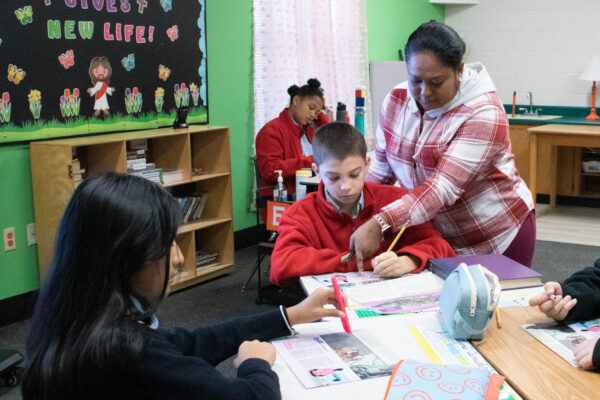Religion
Fifth grade religion focuses on four main concepts:
- Creed – Close attention is paid to the events detailed in the Old Testament and students learn that God is a loving God whose plan for us unfolds throughout history, beginning with creation and heading into eternity.
- Sacraments – Students learn that many of our sacramental celebrations are rooted in the Old Testament and that the revelation of Jesus brings Old Testament traditions and practices to fulfillment.
- Christian Living – Students are able to connect the covenantal relationship with a loving God exhibited in Sacred Scripture with moral decision making.
- Sacred Scripture – Students focus on salvation history as conveyed in the Old Testament, emphasizing that the New Testament is prefigured from the Old Testament.
Resources used for teaching Religion include:
- Following Christ textbook and workbook
- Sacred Bible
- Venture newsletters
- St. Peter’s Catholic Church
Students attend Mass weekly on Thursdays, as well as Holy Days of Obligation. Students plan the Mass and participate in the Liturgy. They also attend the Stations of the Cross during the Lenten season. As part of our Corporal Works of Mercy program, students organize a school wide rosary service in remembrance of Roe vs. Wade and during Respect Life Month. Father Andrew, our parish priest, visits each classroom weekly discussing with the students what they are learning in religion. Sister Agnes also comes in weekly to visit and provide extra assistance in religion, as well as other subject areas. Fifth grade students complete the SCIFF test that is administered by the Diocese of Charleston.
ELA
Students read a wide variety of fiction, nonfiction, classic, and contemporary works to build an understanding of texts. As part of vocabulary, students acquire and use accurately grade-level appropriate general academic and content-specific words and phrases. As part of the writing process, students employ a wide range of strategies as they write and use different writing process elements appropriately to communicate with different audiences for a variety of purposes. Students write informative and narrative compositions. Students demonstrate command of English grammar and usage focusing on pronouns, verbs, adjectives and adverbs, phrases and clauses, capitalization, punctuation, and spelling.
Through our Genius Hour projects that are required each quarter, students are actively engaged in producing projects most commonly created through various media. Students are learning to use Google Classroom and Power Point to create these projects. They learn to listen actively and communicate effectively for a variety of purposes including learning, enjoyment, persuasion, and the exchange of information and ideas.
Resources used to teach ELA include:
- our grammar and vocabulary textbooks
- Words Their Way word study text
- literature book sets
- Google Classroom
- IXL, Khan Academy
- Vocabulary Workshop website
- Brainpop
- MAP website
Students are assessed weekly on spelling and vocabulary, and reading comprehension is assessed regularly. MAP testing is administered to help teachers guide instruction.
Math
Fifth grade uses Saxon Math which spirals, allowing students to continue practicing skills learned in previous lessons. Topics include determining place value from thousandths to billions, adding, subtracting, multiplying and dividing fractions, finding volume of 3D shapes, and converting units within a given measure. Students also learn how to organize data and probability to create and interpret graphs, line plots, and coordinate planes.
Resources used for teaching math include:
- Saxon textbooks
- hands on math manipulatives
- IXL
- Khan Academy
- virtual math manipulatives
- MAP testing website
Science
Students will be able to identify the different types of fossils, how they are formed, and the characteristics of ancient Earth. They will be able to describe the structure of Earth, its theories of continental drift and sea-floor spreading. They will learn about earthquakes, volcanoes, the weather cycle, atmosphere and oceanography. We will discuss and describe the six major climate regions and be capable of distinguishing between weather and climate. Then we will learn about energy resources with contrasting and comparing renewable and non-renewable resources with their advantages and disadvantages, and how natural resources can be conserved.
Social Studies
Students will be learning about the prehistory of Mesopotamia and the early civilizations of ancient Egypt and the Israelites, India and China’s major developments and advancements, Greek and Roman civilizations including their culture, social, political, architecture, scientific discoveries and religious systems. We will discuss the African Empires and the spread of Islam, the Mesoamerica Empires, the Dark Ages to the Medieval Era, and the Early Renaissance. The curriculum will be taught using readings, discussions, interactive notebooks, debates, documentaries, illustrations, scientific investigations, BrainPop, Mystery Doug, research, IXL, Studies Weekly, creating illustrations or posters, creating dioramas, and other approved websites.
5th Grade


